A Nano-Emulsion Containing Ceramide-like Lipo-Amino Acid Cholesteryl Derivatives Improves Skin Symptoms in Patients with Atopic Dermatitis by Ameliorating the Water-Holding Function
Abstract
1. Introduction
2. Results
2.1. Effect of the POLG Nano-Emulsion on Atopic Dry Skin during the 6 Weeks of Treatment
2.2. Clinical Improvement by the POLG Nano-Emulsion
2.3. Skin Surface Evaluation by Visioscan
2.4. Effect of the POLG Nano-Emulsion on TEWL and Conductance Values during the 3 and 6 Weeks of Treatment
2.5. Corneocyte Size, Degree of Thick Abrasions, and Nile Red Dye Staining
3. Discussion
4. Materials and Methods
4.1. Materials
4.2. Study Design
4.3. Patients
4.4. Compliance with Ethical Standards and Ethical Approval
4.5. Clinical Assessments
4.6. Evaluation of Skin Microrelief Parameters
4.7. Biophysical Measurements
4.8. Collection and Transfer of Corneocytes to Glass Slides
4.9. Corneocyte Size and Degree of Thick Abrasions
4.10. Staining of Lipid Envelopes
4.11. Statistical Analyses
Author Contributions
Funding
Institutional Review Board Statement
Informed Consent Statement
Data Availability Statement
Acknowledgments
Conflicts of Interest
Abbreviations
| POLG | phytosteryl/octyldodecyl lauroyl glutamate |
| AD | atopic dermatitis |
| SESC | roughness |
| SESM | smoothness |
| SC | stratum corneum |
| pCer | synthetic pseudoceramide |
| SESC | scaliness |
| TEWL | trans-epidermal water loss |
References
- Imokawa, G.; Ishida, K. Role of ceramide in the barrier function of the stratum corneum, Implications for the pathogenesis of atopic dermatitis. J. Clin. Exp. Dermatol. Res. 2014, 5, 206–218. [Google Scholar] [CrossRef]
- Imokawa, G. Cutting Edge of the Pathogenesis of Atopic Dermatitis: Sphingomyelin Deacylase, the Enzyme Involved in Its Ceramide Deficiency, Plays a Pivotal Role. Int. J. Mol. Sci. 2021, 22, 1613. [Google Scholar] [CrossRef] [PubMed]
- Imokawa, G.; Abe, A.; Jin, K.; Higaki, Y.; Kawashima, M.; Hidano, A. Decreased level of ceramides in stratum corneum of atopic dermatitis: An etiologic factor in atopic dry skin? J. Investig. Dermatol. 1991, 96, 523–526. [Google Scholar] [CrossRef]
- Ishibashi, M.; Arikawa, J.; Okamoto, R.; Kawashima, M.; Takagi, Y.; Ohguchi, K.; Imokawa, G. Abnormal expression of the novel epidermal enzyme, glucosylceramide deacylase, and the accumulation of its enzymatic reaction product, glucosylsphingosine, in the skin of patients with atopic dermatitis. Lab. Investig. 2003, 83, 397–408. [Google Scholar] [CrossRef] [PubMed]
- Sugiura, A.; Nomura, T.; Mizuno, A.; Imokawa, G. Reevaluation of the non-lesional dry skin in atopic dermatitis by acute barrier disruption: An abnormal permeability barrier homeostasis with defective processing to generate ceramide. Arch. Dermatol. Res. 2014, 306, 427–440. [Google Scholar] [CrossRef] [PubMed]
- Okamoto, R.; Arikawa, J.; Ishibashi, M.; Kawashima, M.; Takagi, Y.; Imokawa, G. Sphingosylphosphorylcholine is upregulated in the stratum corneum of patients with atopic dermatitis. J. Lipid Res. 2003, 44, 93–102. [Google Scholar] [CrossRef]
- Arikawa, J.; Ishibashi, M.; Kawashima, M.; Takagi, Y.; Ichikawa, Y.; Imokawa, G. Decreased levels of sphingosine, a natural antimicrobial agent, may be associated with vulnerability of the stratum corneum from patients with atopic dermatitis to colonization by Staphylococcus aureus. J. Investig. Dermatol. 2002, 119, 433–439. [Google Scholar] [CrossRef]
- Ishida, K.T.A.; Bito, K.; Draelos, Z.; Imokawa, G. Treatment with Synthetic Pseudoceramide Improves Atopic Skin, Switching the Ceramide Profile to a Healthy Skin Phenotype. J. Investig. Dermatol. 2020, 140, 1762–1770. [Google Scholar] [CrossRef]
- Higuchi, K.; Hara, J.; Okamoto, R.; Kawashima, M.; Imokawa, G. The skin of atopic dermatitis patients contains a novel enzyme, glucosylceramide sphingomyelin deacylase, which cleaves the N-acyl linkage of sphingomyelin and glucosylceramide. Biochem. J. 2000, 350, 747–756. [Google Scholar] [CrossRef]
- Jin, K.; Higaki, Y.; Takagi, Y.; Higuchi, K.; Yada, Y.; Kawashima, M.; Imokawa, G. Analysis of beta-glucocerebrosidase and ceramidase activities in atopic and aged dry skin. Acta Derm. Venereol. 1994, 74, 337–340. [Google Scholar] [CrossRef]
- Murata, Y.; Ogata, J.; Higaki, Y.; Kawashima, M.; Yada, Y.; Higuchi, K.; Tsuchiya, T.; Kawainami, S.; Imokawa, G. Abnormal expression of sphingomyelin acylase in atopic dermatitis: An etiologic factor for ceramide deficiency? J. Investig. Dermatol. 1996, 106, 1242–1249. [Google Scholar] [CrossRef] [PubMed]
- Hara, J.; Higuchi, K.; Okamoto, R.; Kawashima, M.; Imokawa, G. High-expression of sphingomyelin deacylase is an important determinant of ceramide deficiency leading to barrier disruption in atopic dermatitis. J. Investig. Dermatol. 2000, 115, 406–413. [Google Scholar] [CrossRef] [PubMed]
- Imokawa, G. A possible mechanism underlying the ceramide deficiency in atopic dermatitis: Expression of a deacylase enzyme that cleaves the N-acyl linkage of sphingomyelin and glucosylceramide. J. Dermatol. Sci. 2009, 55, 1–9. [Google Scholar] [CrossRef]
- Teranishi, Y.; Kuwahara, H.; Ueda, M.; Takemura, T.; Kusumoto, M.; Nakamura, K.; Sakai, J.; Kimura, T.; Furutani, Y.; Kawashima, M.; et al. Sphingomyelin Deacylase, the Enzyme Involved in the Pathogenesis of Atopic Dermatitis, Is Identical to the beta-Subunit of Acid Ceramidase. Int. J. Mol. Sci. 2020, 21, 8789. [Google Scholar] [CrossRef] [PubMed]
- Matsuki, H.; Kiyokane, K.; Matsuki, T.; Sato, S.; Imokawa, G. Recharacterization of the Nonlesional Dry Skin in Atopic Dermatitis through Disrupted Barrier Function. Exog. Dermatol. 2004, 3, 282–292. [Google Scholar] [CrossRef]
- Hata, M.; Tokura, Y.; Takigawa, M.; Sato, M.; Shioya, Y.; Fujikura, Y.; Imokawa, G. Assessment of epidermal barrier function by photoacoustic spectrometry in relation to its importance in the pathogenesis of atopic dermatitis. Lab. Investig. 2002, 82, 1451–1461. [Google Scholar] [CrossRef][Green Version]
- Imokawa, G.; Akasaki, S.; Kuno, O.; Zama, M.; Kawai, M.; Minematsu, Y. Function of lipids on human skin. J. Dispers. Sci. Technol. 1989, 10, 617–641. [Google Scholar] [CrossRef]
- Imokawa, G. Chapter 3. vitro and in vivo models. In Bioengineering of Skin: Water and the Stratum Corneum; Elsner, P., Berardesca, E., Maibach, H.I., Eds.; CRC Press: Boca Raton, FL, USA, 1994; Volume 1, pp. 23–47. [Google Scholar]
- Imokawa, G.; Akasaki, S.; Hattori, M.; Yoshizuka, N. Selective recovery of deranged water-holding properties by stratum corneum lipids. J. Investig. Dermatol. 1986, 87, 758–761. [Google Scholar] [CrossRef]
- Imokawa, G.; Akasaki, S.; Minematsu, Y.; Kawai, M. Importance of intercellular lipids in water-retention properties of the stratum corneum: Induction and recovery study of surfactant dry skin. Arch. Dermatol. Res. 1989, 281, 45–51. [Google Scholar] [CrossRef]
- Imokawa, G.; Akasaki, S.; Kawamata, A.; Yano, S.; Takaishi, N. Water-retaining function in the stratum corneum and its recovery propertiess by synthetic pseudoceramides. J. Soc. Cosmet. Chem. 1989, 40, 273–285. [Google Scholar]
- Imokawa, G.; Kuno, H.; Kawai, M. Stratum corneum lipids serve as a bound-water modulator. J. Investig. Dermatol. 1991, 96, 845–851. [Google Scholar] [CrossRef] [PubMed]
- Imokawa, G.; Yada, Y.; Higuchi, K.; Okuda, M.; Ohashi, Y.; Kawamata, A. Pseudo-acylceramide with linoleic acid produces selective recovery of diminished cutaneous barrier function in essential fatty acid-deficient rats and has an inhibitory effect on epidermal hyperplasia. J. Clin. Investig. 1994, 94, 89–96. [Google Scholar] [CrossRef] [PubMed]
- Mizutani, H.; Takahashi, M.; Shimizu, M.; Kariya, K.; Sato, H.; Imokawa, G. Usage of pseudoceramide cream in atopic dry skin in comparison with 10% urea cream. Nishinihon J. Dermatol. 2001, 63, 457–461. [Google Scholar] [CrossRef]
- Imokawa, G. Surfactant-induced depletion of ceramides and other intercellular lipids: Implication for the mechanism leading to dehydration of the stratum corneum. Exog. Dermatol. 2004, 3, 81–98. [Google Scholar] [CrossRef]
- Matsuki, H.; Kiyokane, K.; Matsuki, T.; Sato, S.; Imokawa, G. Reevaluation of the Importance of Barrier Dysfunction in the Nonlesional Dry Skin of Atopic Dermatitis Patients through the Use of Two Barrier Creams. Exog. Dermatol. 2004, 3, 293–302. [Google Scholar] [CrossRef]
- Nakamura, T.; Satoh, H.; Imokawa, G.; Miachi, Y. Clinical test of skin care products on atopic dry skin. Skin Res. 2000, 42, 264–269. [Google Scholar]
- Nakamura, T.; Honma, M.; Kashiwagi, T.; Sakai, H.; Hashimoto, Y.; Iizuka, H. Clinical evaluation of synthetic pseudo-ceramide cream on atopic dermatitis. Nishinihon J. Dermatol. 1999, 61, 671–681. [Google Scholar] [CrossRef]
- Ishii, H. Characteristic properties and application of amino acid based ester. Oleoscience 2004, 4, 97–103. [Google Scholar] [CrossRef]
- Ishii, H.; Mikami, N.; Sakamoto, K. Lipo-amino acid cholesteryl derivatives promoto recovery effect for damaged skin. J. Soc. Cosmet. Chem. 1996, 47, 351–362. [Google Scholar]
- Yamanaka, M.; Ishikawa, O.; Takahashi, A.; Sato, H.; Imokawa, G. Clinical evaluation of Curel medicated cream in patients with atopic dermatitis. Skin Res. 2001, 43, 278–285. [Google Scholar]
- Melton, J.L.; Wertz, P.W.; Swartzendruber, D.C.; Downing, D.T. Effects of essential fatty acid deficiency on epidermal O-acylsphingolipids and transepidermal water loss in young pigs. Biochim. Biophys. Acta 1987, 921, 191–197. [Google Scholar] [CrossRef]
- Kawai, M.; Imokawa, G.; Mizoguchi, M. Physiological analysis of the facial skin by corneocyte morphology and stratum corneum turnover. Nihon Hifuka Gakkai Zasshi 1989, 99, 999–1006. [Google Scholar] [PubMed]
- Leung, D.Y. Atopic dermatitis: New insights and opportunities for therapeutic intervention. J. Allergy Clin. Immunol. 2000, 105, 860–876. [Google Scholar] [CrossRef] [PubMed]
- Hanifin, J.M.; Rajka, G. Diagnostic features of atopic dermatitis. Acta Derm. Venereol. 1989, 92, 44–47. [Google Scholar]
- Rajka, G.; Langeland, T. Grading of the severity of atopic dermatitis. Acta Dermatovenereol. Suppl. 1989, 144, 13–14. [Google Scholar]
- Doi, M.; Sagawa, Y.; Momose, S.; Tanaka, T.; Mizutani, T.; Okano, Y.; Masaki, H. Topical treatment with sacran, a sulfated polysaccharide from Aphanothece sacrum, improves corneocyte-derived parameters. J. Dermatol. 2017, 44, 1360–1367. [Google Scholar] [CrossRef]
- de Melo, M.O.; Campos, M. Characterization of oily mature skin by biophysical and skin imaging techniques. Skin Res. Technol. 2018, 24, 386–395. [Google Scholar] [CrossRef]

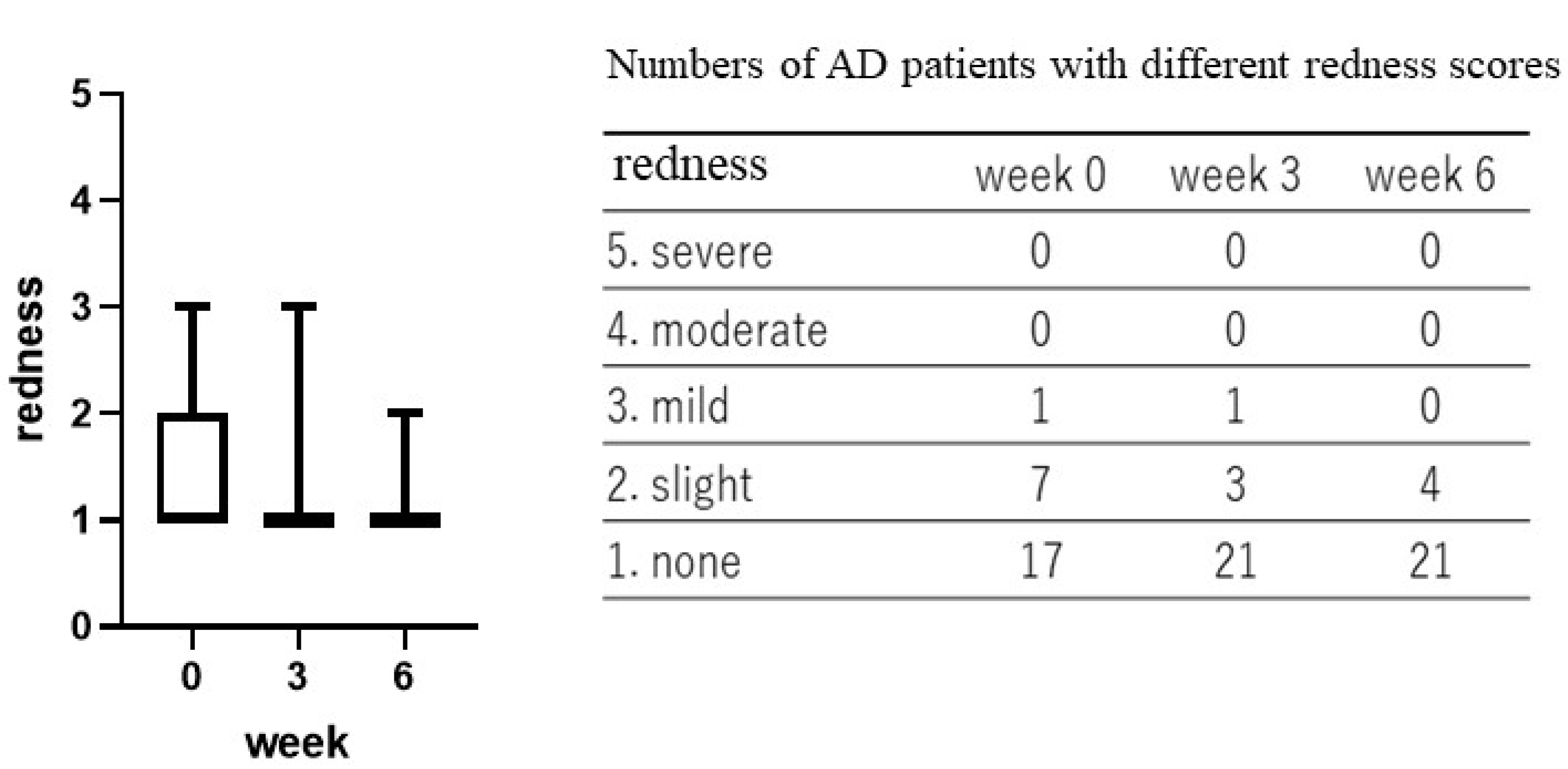
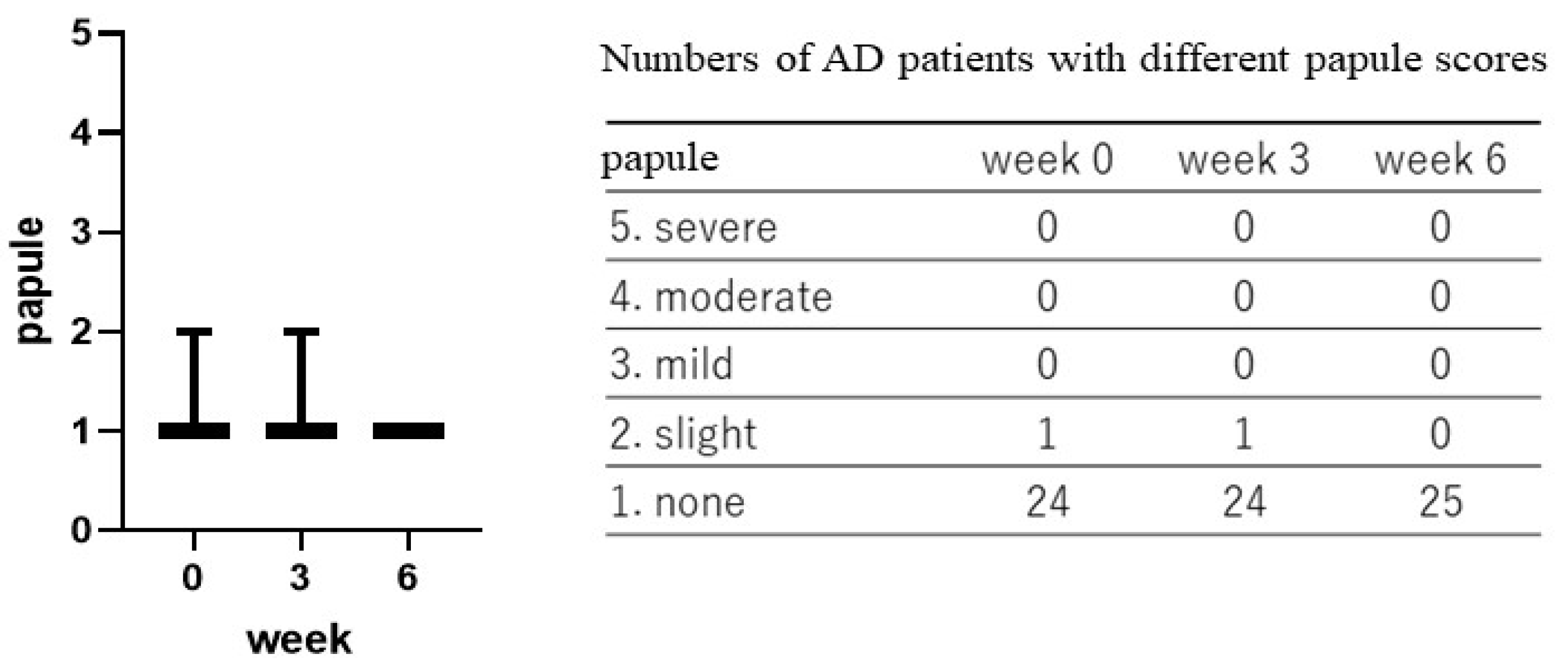
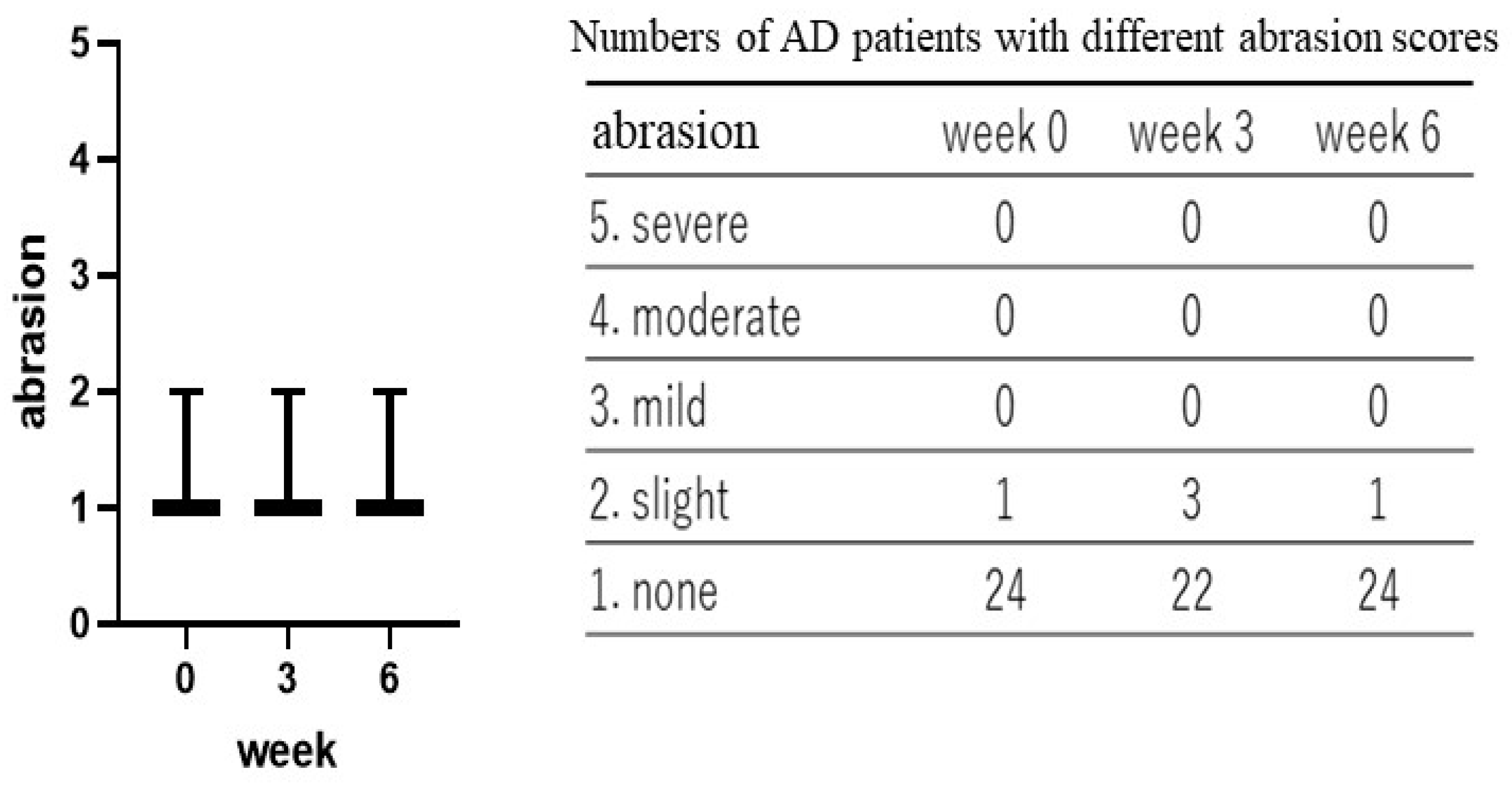
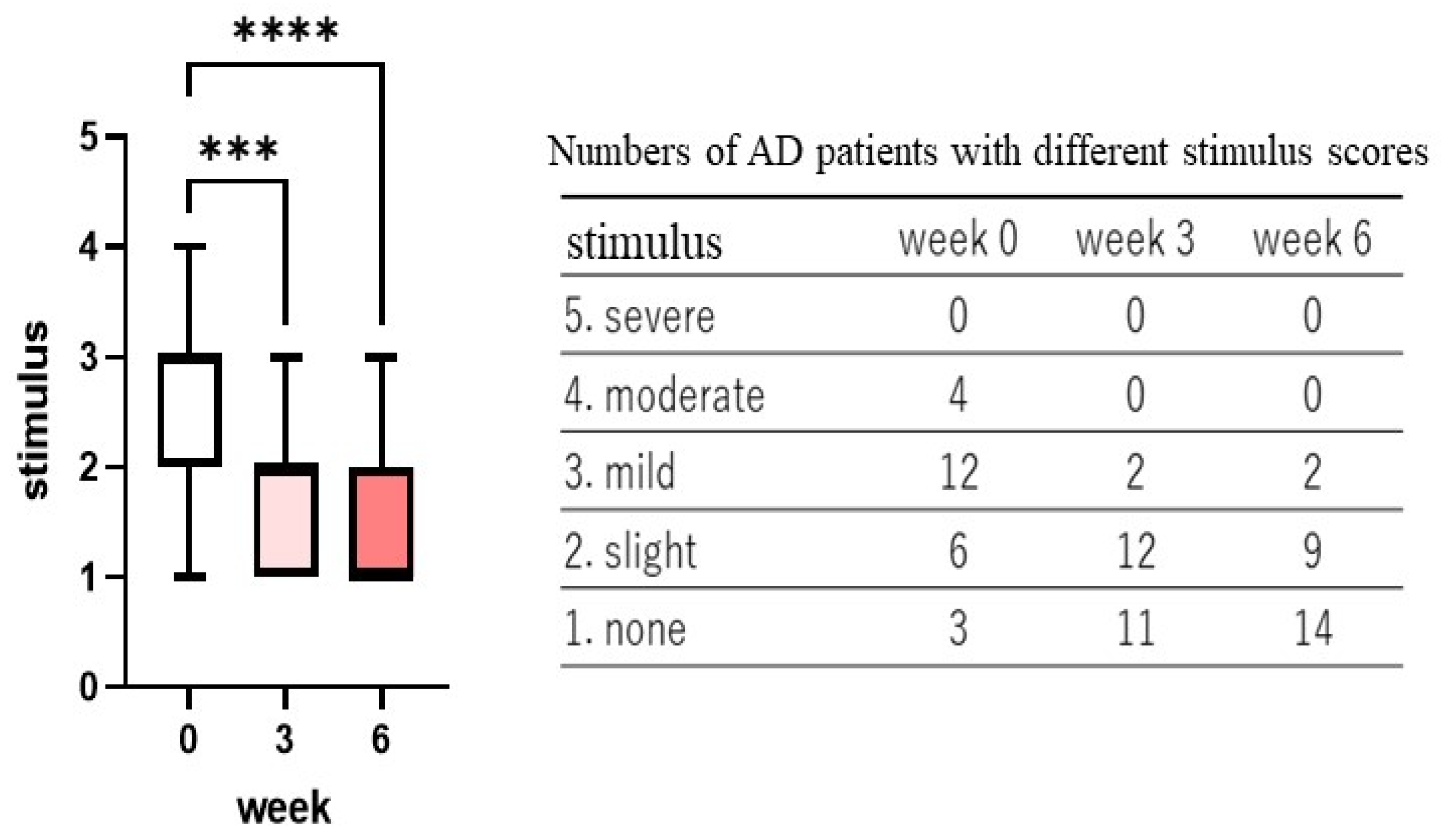
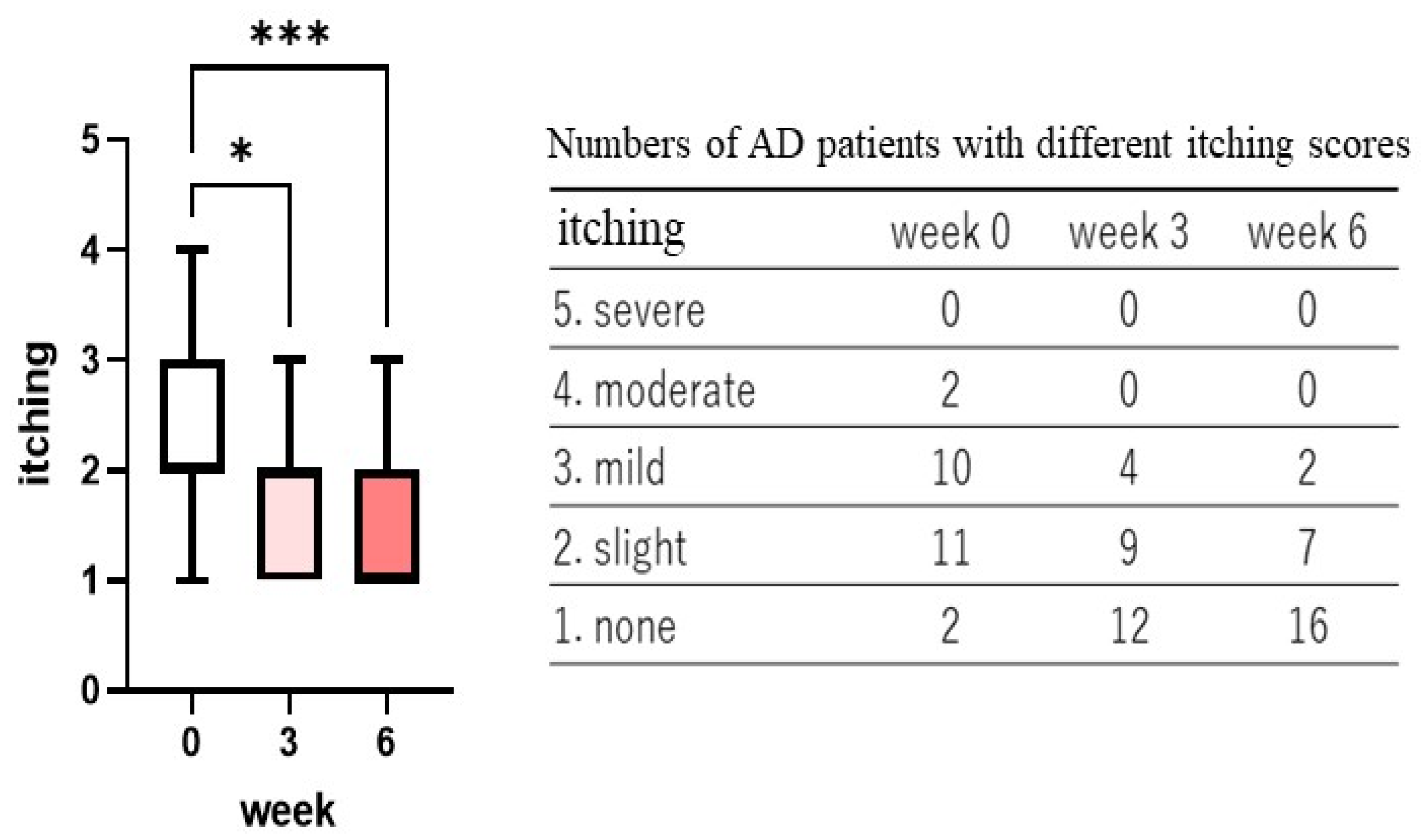
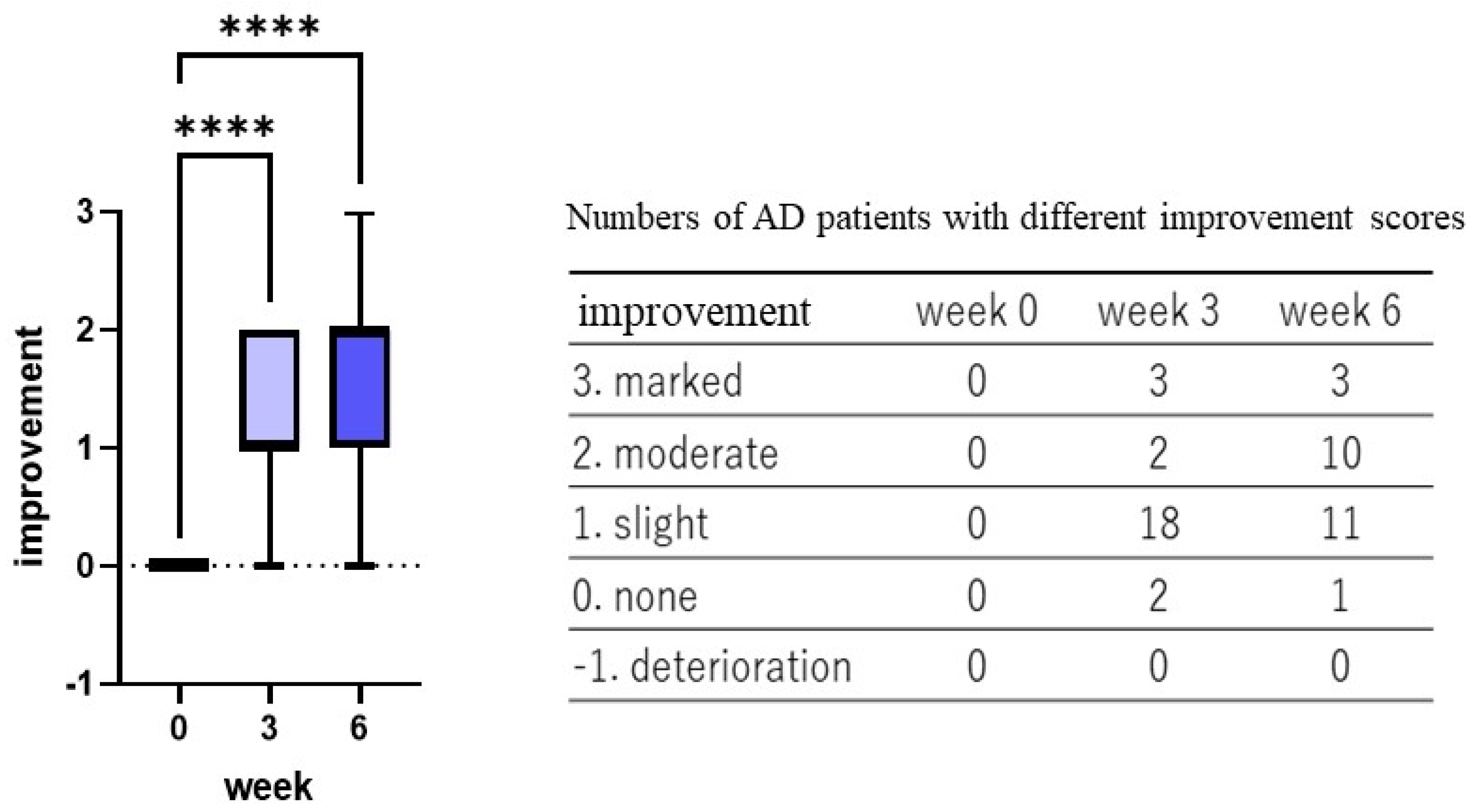
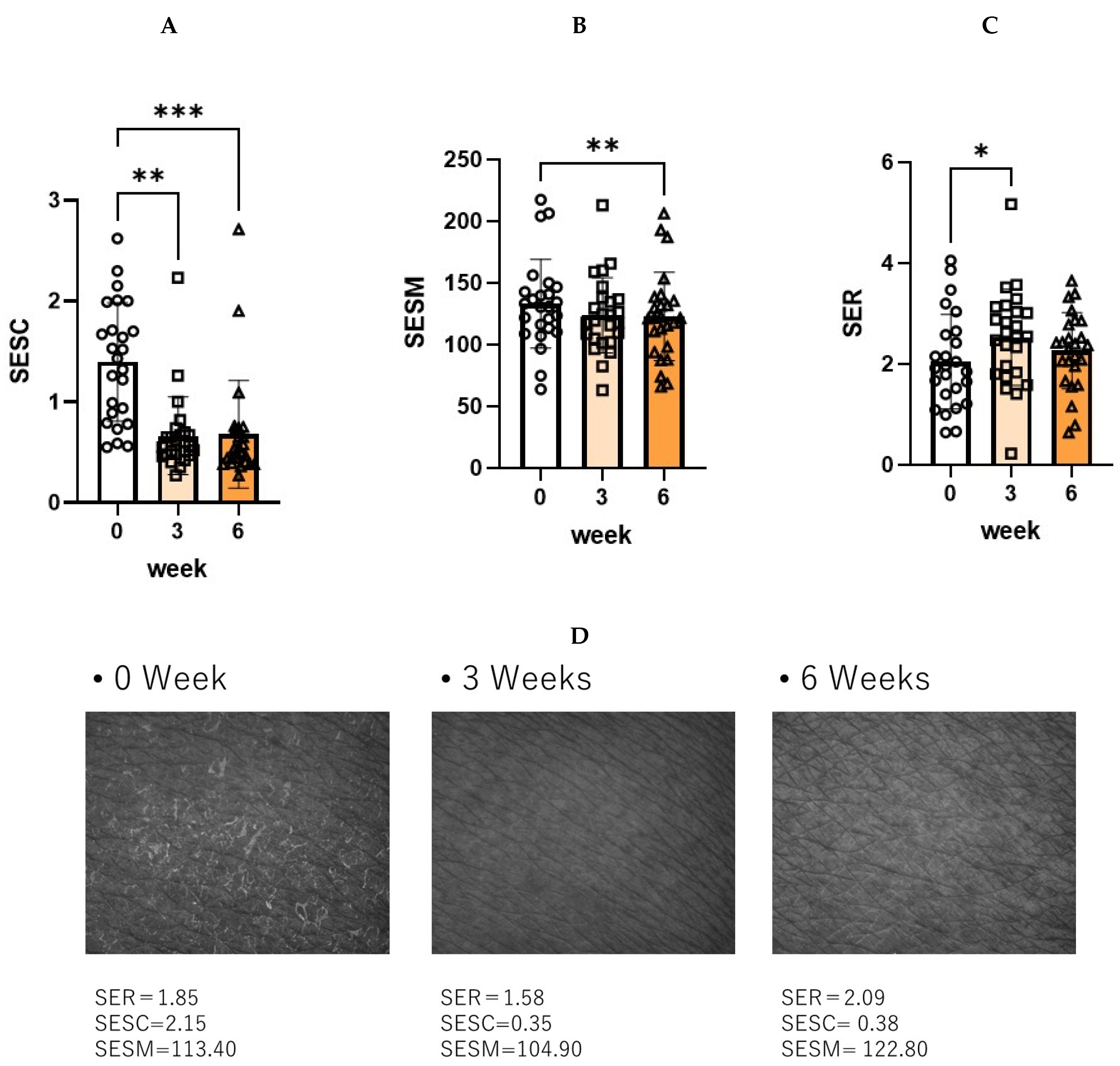
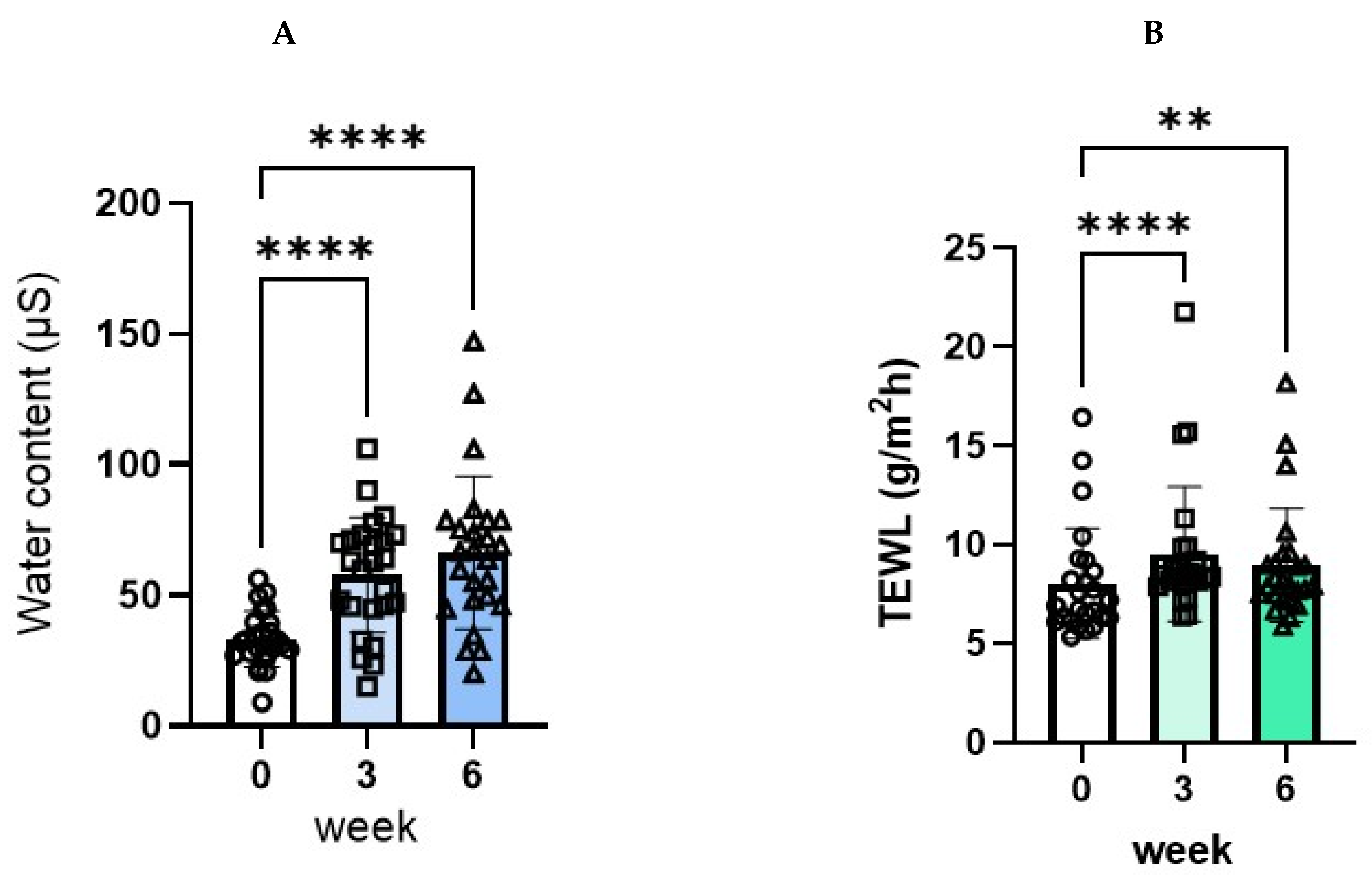
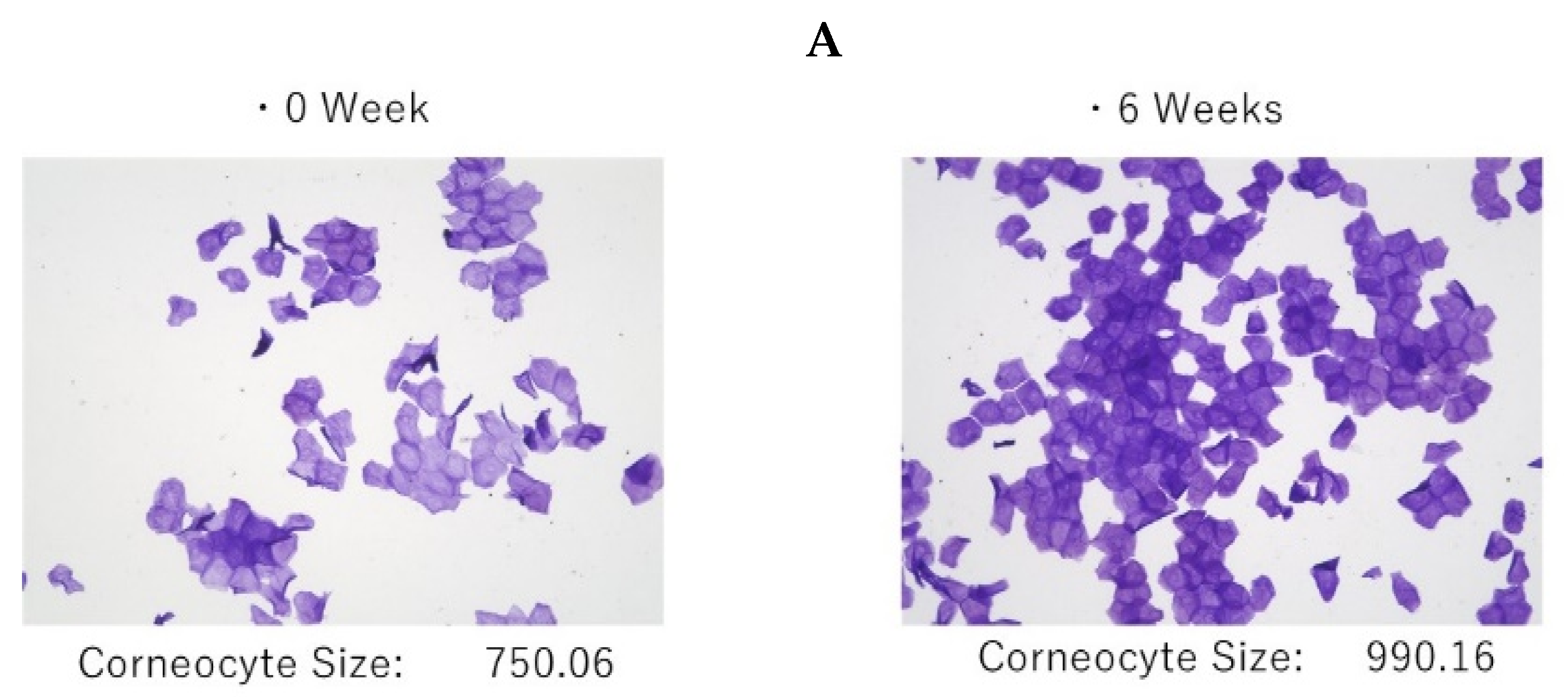
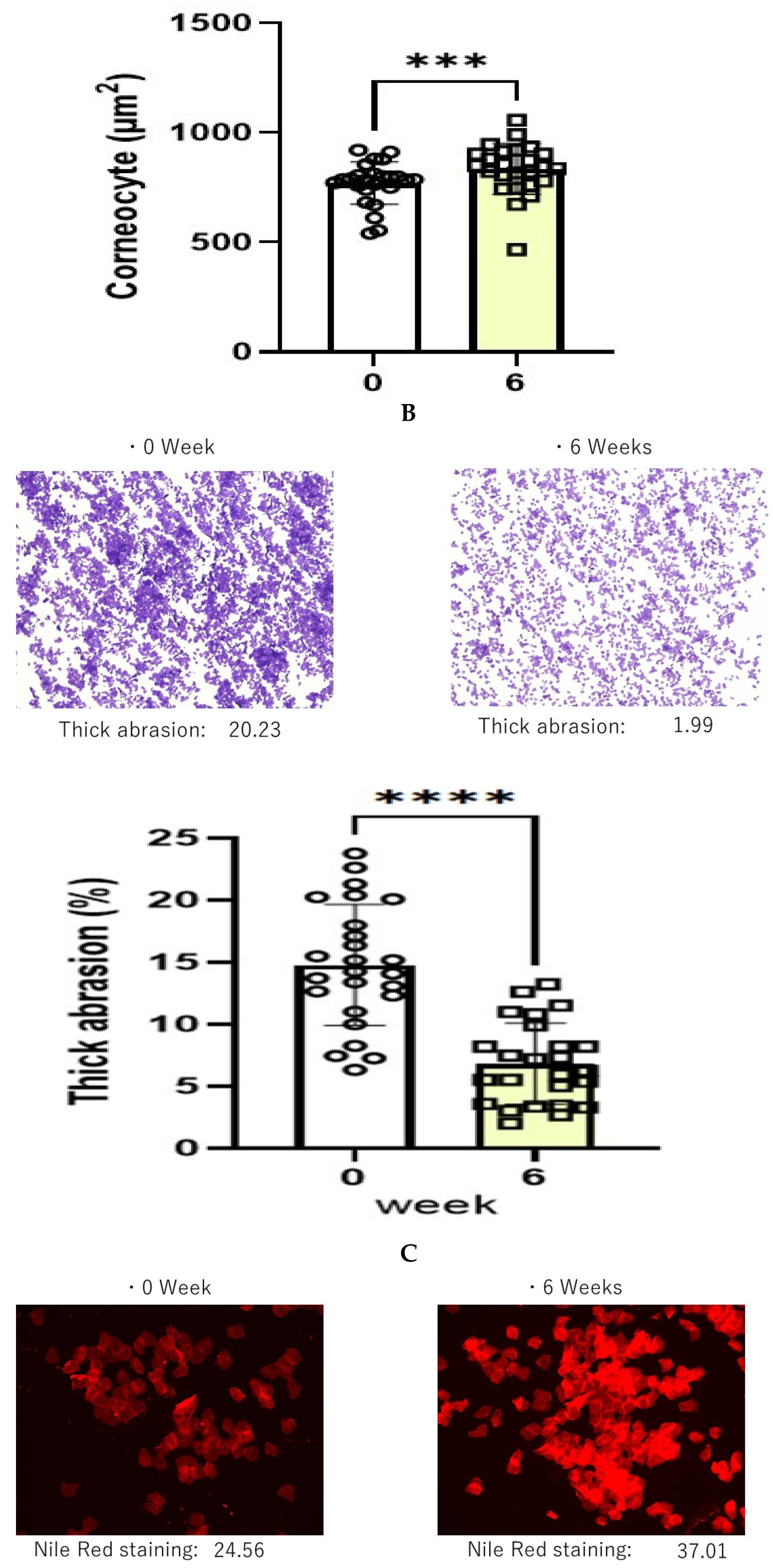
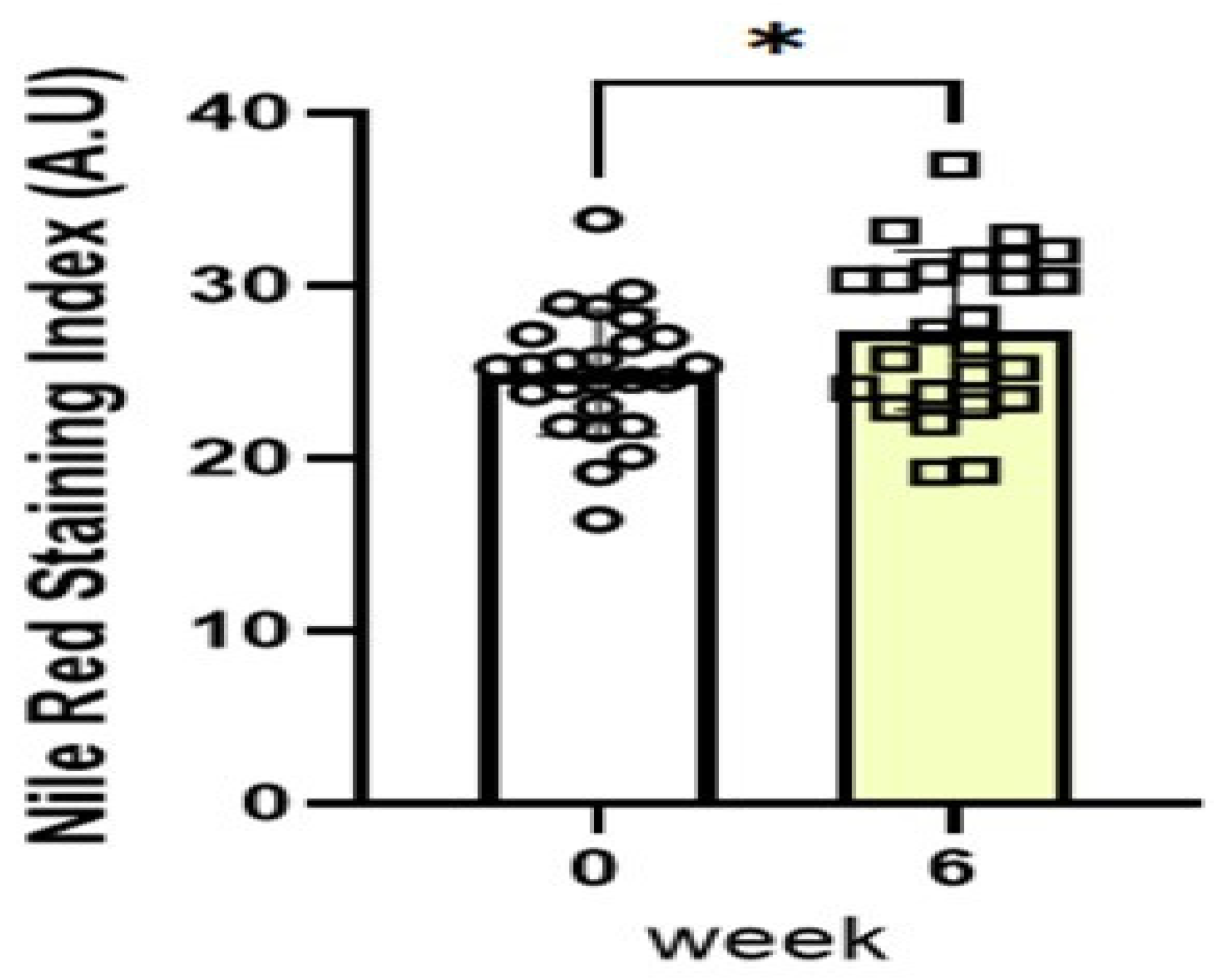
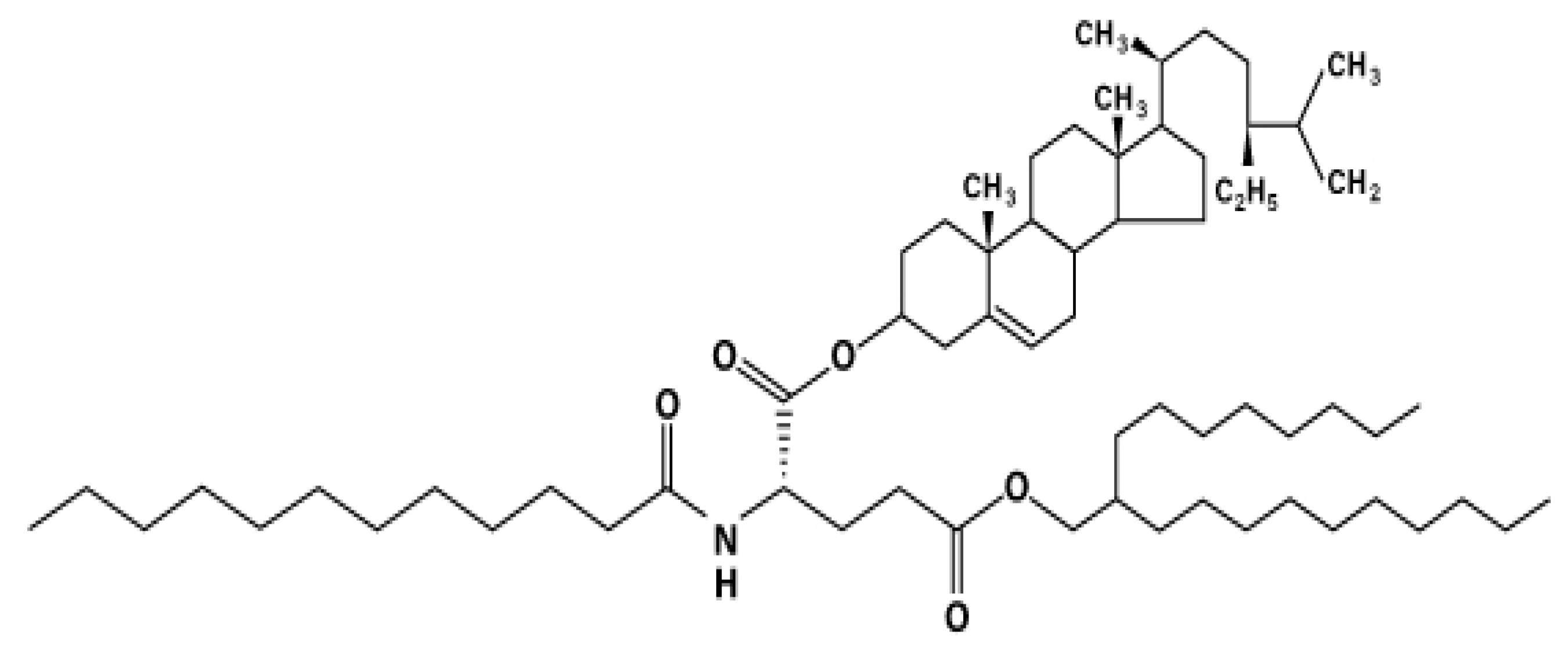
| Water |
| Phytosteryl/Octyldodecyl Lauroyl Glutamate (POLG); 10.0% |
| Glycerin |
| Butylene Glycol |
| Dipropylene Glycol |
| Pentylene Glycol |
| Hydrogenated Lecithin |
| Lactobacillus/Wasabia Japonica Root Ferment Extract |
| Polyglyceryl-10 Laurate |
| Sodium Pyrrolidone Carboxylic Acid |
| Ceramide 3 |
| Pyrrolidone Carboxylic Acid |
| Arginine |
| Aspartic Acid |
| Glycine |
| Alanine |
| Serine |
| Valine |
| Isoleucine |
| Threonine |
| Proline |
| Histidine |
| Phenylalanine |
| Saccharide Isomerate |
| Rosmarinus Officinalis (Rosemary) Leaf Extract |
| Polyquaternium-51 |
| Lactobacillus Ferment |
| Phenoxyethanol |
| Sodium Lactate |
Publisher’s Note: MDPI stays neutral with regard to jurisdictional claims in published maps and institutional affiliations. |
© 2022 by the authors. Licensee MDPI, Basel, Switzerland. This article is an open access article distributed under the terms and conditions of the Creative Commons Attribution (CC BY) license (https://creativecommons.org/licenses/by/4.0/).
Share and Cite
Takada, M.; Ishikawa, Y.; Numano, K.; Hirano, S.; Imokawa, G. A Nano-Emulsion Containing Ceramide-like Lipo-Amino Acid Cholesteryl Derivatives Improves Skin Symptoms in Patients with Atopic Dermatitis by Ameliorating the Water-Holding Function. Int. J. Mol. Sci. 2022, 23, 13362. https://doi.org/10.3390/ijms232113362
Takada M, Ishikawa Y, Numano K, Hirano S, Imokawa G. A Nano-Emulsion Containing Ceramide-like Lipo-Amino Acid Cholesteryl Derivatives Improves Skin Symptoms in Patients with Atopic Dermatitis by Ameliorating the Water-Holding Function. International Journal of Molecular Sciences. 2022; 23(21):13362. https://doi.org/10.3390/ijms232113362
Chicago/Turabian StyleTakada, Mariko, Yuko Ishikawa, Kayoko Numano, Shinichi Hirano, and Genji Imokawa. 2022. "A Nano-Emulsion Containing Ceramide-like Lipo-Amino Acid Cholesteryl Derivatives Improves Skin Symptoms in Patients with Atopic Dermatitis by Ameliorating the Water-Holding Function" International Journal of Molecular Sciences 23, no. 21: 13362. https://doi.org/10.3390/ijms232113362
APA StyleTakada, M., Ishikawa, Y., Numano, K., Hirano, S., & Imokawa, G. (2022). A Nano-Emulsion Containing Ceramide-like Lipo-Amino Acid Cholesteryl Derivatives Improves Skin Symptoms in Patients with Atopic Dermatitis by Ameliorating the Water-Holding Function. International Journal of Molecular Sciences, 23(21), 13362. https://doi.org/10.3390/ijms232113362






